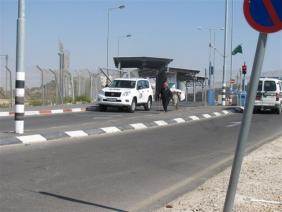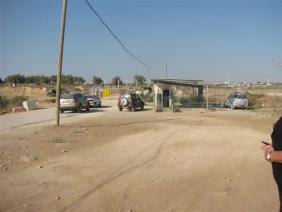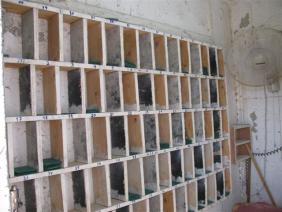Routes 443-446, Giv’at Ze’ev, Bitunya, Hashmona’im, Kharbata 7.9.11, afternoon
Translator: Charles K.
Military-civil symbiosis
15:30 We drove on Route 443 to Giv’at Ze’ev.

The checkpoint begins operating when the laborers return from work, on foot or transported by the contractor. They’re not checked when they return. We saw only a few vehicles with diplomatic license plates going in the other direction, and a donkey and rider going through the vehicle lane (see photo on the left).
Bitunya checkpoint is blocked by concrete cubes.
All the villages to the left and right of Route 443 are closed off by iron gates . That’s nothing new, but it’s important to keep mentioning it.
. That’s nothing new, but it’s important to keep mentioning it.
We took route 446 across the Green Line, into the unknown. Lapid and Modi’in Illit.
Route 463 leads to Na’aleh, Nili, Neria and other places. We continued part of the way on the road connecting 443 to Route 60, to Talmon, Dolev and Halamish, returning toward Modi’in Illit.
16:40 Hashmona’im checkpoint, adjoining the entrance to Na’alin, now stands to the glory of the state of Israel. The road is wide and new, various structures along its western edge.
We drove into Modi’in Illit, drove through the “city” to its northern boundary and then via a dirt road arrived back at the checkpoint. Please meet the Kharbata checkpoint (according to the guards). This checkpoint (see photo) is an example of the symbiosis between the military and the civil, and the system it creates. It’s not visible from anywhere. A little inspection building operated by two civilian security personnel, employed by a security company hired by the Modi’in Illit municipality. Each has a 4x4 vehicle.
Kharbata checkpoint (according to the guards). This checkpoint (see photo) is an example of the symbiosis between the military and the civil, and the system it creates. It’s not visible from anywhere. A little inspection building operated by two civilian security personnel, employed by a security company hired by the Modi’in Illit municipality. Each has a 4x4 vehicle.
An army checkpoint some 10-15 meters past them, an army vehicle and three soldiers standing at the entrance of the fence around the entire area, which isn’t “Israel”! At this hour, laborers are returning from work. They enter the inspection building, get their IDs and pass by the soldiers on their way home, without any additional inspection. The atmosphere is pleasant and friendly, everyone’s demonstratively “buddy-buddy.” For our benefit they ask, “Ana mabsut?” [“Everything OK?”]
Here’s how it works:
Open in the morning between 05:00-07:00.
Laborers arrive from the whole area, are checked by the soldiers – of course, only those with work permits cross.
They leave their IDs in the inspection building that belongs to the Modi’in Illit municipality, in a cupboard with cubbyholes (see photo to the left).
that belongs to the Modi’in Illit municipality, in a cupboard with cubbyholes (see photo to the left).
The inspection building is open between 15:00-17:00 in the afternoon, and again beween 19:00-19:15.
And if somebody is late? “He’s got a number to call, and we’ll come open it.”
And, in fact, at 17:00 inspections stop. The last laborer comes running and goes through the army position without picking up his ID. And right at this hour the soldiers get in their vehicle and drive away.
That’s it – the area is closed.
The explanation we received lays out the system under which Palestinians are employed in the settlements. Each settlement has its own laborers, who hand their IDs to the security coordinator when they come to work. Since Modi’in Illit is a large city/locality/ settlement, its security company fulfills the role of security coordinator. It collects the IDs and makes sure that whoever enters also leaves.
